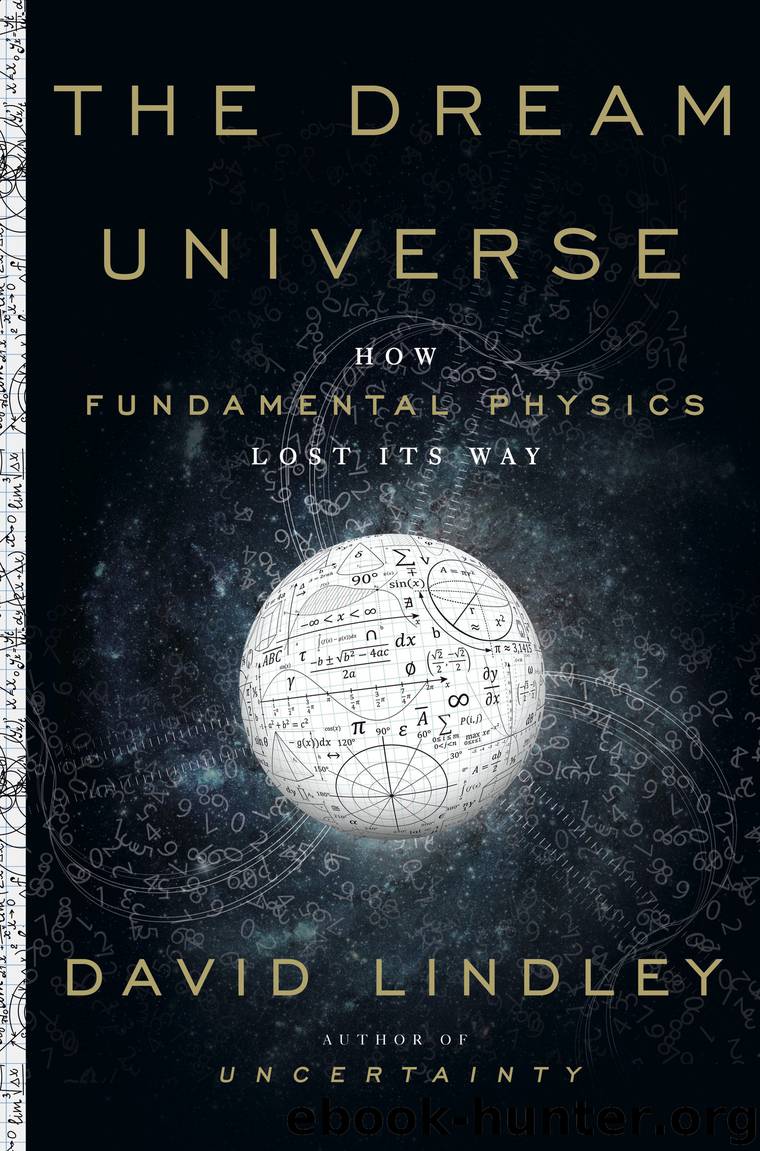The Dream Universe by David Lindley

Author:David Lindley
Language: eng
Format: epub
Publisher: Knopf Doubleday Publishing Group
Published: 2020-03-16T16:00:00+00:00
10
Wigner’s Enigmatic Question
Dirac may not have started the modern revolution in particle physics, but he gave it an intellectual foundation. New subatomic particles arrived on the scene, singly at first but later in battalions. These newcomers had both experimental and theoretical origins. In 1930, the same year that Dirac predicted the antielectron, Wolfgang Pauli came up with another prediction, but for empirical reasons. In radioactive beta decays, the particles leaving the scene of the crime have less total energy than the particles that went in, and Pauli suggested that the missing energy was carried away by a neutral and elusive particle that was also produced in the decay. He called it the neutron, but in 1932, James Chadwick found the other neutron, the charge-free companion to the proton that gives atomic nuclei additional mass. Enrico Fermi renamed Pauli’s particle the neutrino, the baby neutron, and although it wasn’t discovered until 1956 it quickly became part of the furnishings of particle physics, so essential to theoretical coherence did it seem. In 1935, Hideki Yukawa, a Japanese theorist, proposed a new type of particle he called a meson, because it was intermediate in mass between the light electron and the much heavier proton and neutron. The justification for the meson was theoretical: Yukawa intended it as a sort of glue that kept atomic nuclei together. The positive charges of protons in a nucleus generate powerful electromagnetic repulsion trying to tear the assembly apart, so there had to be a still stronger force—the strong nuclear interaction, it was imaginatively named—holding everything together. The following year, cosmic ray experiments (the only way to study particles with very high energy, until accelerators came along) revealed something that looked as if it might be Yukawa’s meson, but further investigation showed it to be a heavy sibling of the electron—something no one had asked for, but there it was. It was called the mu-meson at first, then simply the muon. Not until 1947 was the first true meson found, the pion. Another meson, the kaon, was found not long afterward.
That’s enough of that. The emergence of particle physics in the twentieth century is elegantly recounted by Robert Crease and Charles Mann in their 1986 book, The Second Creation. The story includes painstaking searches for elusive particles suspected to exist, entirely unexpected discoveries, theoretical predictions that came true, theoretical predictions that didn’t, all in the context of attempts to find order and organization among the proliferating parade of mostly short-lived particles that were found as experimenters learned to smash electrons and protons and atomic nuclei together at ever higher speeds and sort through the resulting debris.
Even though physicists spoke of “particles” as if they were little objects flying about, they had surely moved beyond the Newtonian world of tiny billiard balls. To calculate how all these new particles would behave, theorists had to describe them in terms of quantum wave functions and calculate probabilities, not certainties, for this or that outcome. The old word “particle” prevailed, out of habit and convenience, but the underlying concepts were very different.
Download
This site does not store any files on its server. We only index and link to content provided by other sites. Please contact the content providers to delete copyright contents if any and email us, we'll remove relevant links or contents immediately.
The Complete Stick Figure Physics Tutorials by Allen Sarah(7339)
Secrets of Antigravity Propulsion: Tesla, UFOs, and Classified Aerospace Technology by Ph.D. Paul A. Laviolette(5338)
Thing Explainer by Randall Munroe(3911)
The River of Consciousness by Oliver Sacks(3574)
The Order of Time by Carlo Rovelli(3164)
How To by Randall Munroe(3078)
A Brief History of Time by Stephen Hawking(2995)
I Live in the Future & Here's How It Works by Nick Bilton(2963)
What If?: Serious Scientific Answers to Absurd Hypothetical Questions by Randall Munroe(2674)
The Great Unknown by Marcus du Sautoy(2666)
Midnight in Chernobyl by Adam Higginbotham(2520)
Blockchain: Ultimate Step By Step Guide To Understanding Blockchain Technology, Bitcoin Creation, and the future of Money (Novice to Expert) by Keizer Söze(2469)
Networks: An Introduction by Newman Mark(2383)
The Meaning of it All by Richard Feynman(2320)
Easy Electronics by Charles Platt(2310)
The Tao of Physics by Fritjof Capra(2247)
Midnight in Chernobyl: The Untold Story of the World's Greatest Nuclear Disaster by Adam Higginbotham(2200)
Introducing Relativity by Bruce Bassett(2098)
When by Daniel H Pink(2098)
